The texture of the egg is very nice. The preserved sea urchin has a rather unique flavor. This is a very interesting and good dish.
Sunday, January 10, 2010
Sea urchin with preserved sea urchin flavored scrambled egg 雲丹と粒雲丹スクランブルドエッグ
This is a variation on Mark's book p148. I have not yet made the lobster sauce according to the original recipe but I am, again, modifying the original recipe. My mother sent us "preserved" sea urchin called "tsubu uni" 粒雲丹. I do not know the details but they are salted and alcohol is added (and other things I am sure). This type of uni can be preserved for rather a long time. It has quite a different taste (rather salty) and texture from fresh sea urchin but it has its own interesting flavor and texture. You could enjoy this by just "licking" it as you drink sake. Since we got fresh sea urchin, I came up with this dish which is a modification of the recipe in Mark's book p148. The idea is to flavor scrambled eggs with the "preserved" sea urchin and place fresh sea urchin on the top.

I put 1 tbs of cream and a half tsp of the "preserved" sea urchin in a small bowl food processor and mixed them well. Beat one large egg and add to this cream mixture. On low heat, put 1tsp of butter in a none-stick frying pan. Add the egg mixture and using a silicon spatula, scramble rapidly to make a creamy soft scrambled egg. Add cracked pepper (the preserved sea urchin is salty so I omitted salt). Place the scrambled egg in the bottom of a small serving bowl (in my case, the egg shaped bowls), top it with fresh sea urchin. I garnished the egg with chopped chives and the fresh sea urchin with "aonori" powder and drizzled soy sauce with wasabi dissolved in it.
Friday, January 8, 2010
Salmon marinated in sweet miso 鮭の西京味噌焼き
For us, crispy skin, either fish or chicken, is the best part. One of the great American sushi creations is called "salmon skin roll" using grilled or toasted crispy salmon skin in a small roll. The only way to make skin crispy without over cooking the fish is to cook the skin and fish separately. Here I removed the skin from a salmon fillet and cooked it separately with a good result.
The fish part was marinated in a sweet miso "saikyo miso" 西京味噌 (same amount of miso and mirin, heat to make marinade and cool to room temperature). This is a very similar marinade in Mark's book "Sweet miso marinated fish 魚の西京漬け" (p61). I marinated for 30 minutes but you could go longer. The longer you marinate the more intense the miso flavor will become. You have to dicide how long is to your liking. I will marinate longer when using white meat fish without its own strong flavors such a cod. After 30 minutes, I remove the miso marinade, wash and pat dry. Then put the fish on a metal grate with a pan undereath and place them in a 350F oven from 10-15 minutes or until done (or you could also grill it).
Meanwhile, I salt the salmon skin and place on a non-stick frying pan (no oil needed) and put an identical sized frying pan nested on top (I cover the bottom of the top pan with aluminum foil so that I do not have to clean both pans). I suppose you could use a brick wrapped with aluminum foil but I have not tried it. On low-medium heat, cook 5-7 minutes and then turn the skin over for another 5 minutes or until the skin is very stiff and crispy.
I served this with simply boiled small green beans. We loved the skin more than the fish itself.
The fish part was marinated in a sweet miso "saikyo miso" 西京味噌 (same amount of miso and mirin, heat to make marinade and cool to room temperature). This is a very similar marinade in Mark's book "Sweet miso marinated fish 魚の西京漬け" (p61). I marinated for 30 minutes but you could go longer. The longer you marinate the more intense the miso flavor will become. You have to dicide how long is to your liking. I will marinate longer when using white meat fish without its own strong flavors such a cod. After 30 minutes, I remove the miso marinade, wash and pat dry. Then put the fish on a metal grate with a pan undereath and place them in a 350F oven from 10-15 minutes or until done (or you could also grill it).
Meanwhile, I salt the salmon skin and place on a non-stick frying pan (no oil needed) and put an identical sized frying pan nested on top (I cover the bottom of the top pan with aluminum foil so that I do not have to clean both pans). I suppose you could use a brick wrapped with aluminum foil but I have not tried it. On low-medium heat, cook 5-7 minutes and then turn the skin over for another 5 minutes or until the skin is very stiff and crispy.
I served this with simply boiled small green beans. We loved the skin more than the fish itself.
Wednesday, January 6, 2010
Eggs Benedict エッグスベネデクト
This is certainly not an Izakaya food but I decided to post it anyway. Sometimes eating breakfast for dinner is a wonderful thing and this dish only goes with good sparkling wines (Champagne, Cava or Prosecco). So it could be possible to have this for a late night snack or something for celebration (we do not think we can eat this late at night). Obviously, this is not "low" fat or low calory and we eat this only on very special occasions. We need four components to make this dish; 1. bread, 2. Canadian bacon, 3. poached egg, and 4. Hollandaise sauce.
1. Bread: The bread is transitionally an English muffin which I used to make but, recently my wife started making "English muffin loaf bread" which has a same texture and taste of English muffin and it is bit easier to make (for one thing, you need not to struggle to put the sticky dough into individual rings, but most importantly, I do not have to make it!). My wife recipe may be different but here is one I found on line.
2. Bacon: This time, I did not have Canadian bacon so I used chicken breast and half a strip of bacon to add bacon flavor. I cut half a strip of bacon into small pieces and made them crispy by rendering the bacon fat in a small frying pan. I removed the bacon bits from the pan and added slices of pre-cooked chicken (one I made few days ago) breast and saute for 30 seconds on each side to add bacon flavor and to warm.
3. Poached eggs: We poach eggs very simply using a small (8 inch) non-stick frying pan. Use one with a high side (not for a French omelet kind) so that enough water can be added allowing the egg yolk to be totally submerged. Add 1/2 tsp of salt (I do not add vinegar since we do not need it and do not like the vinegar flavor in our eggs). When it comes to simmer, break eggs in small cups and gently slide them in the hot water. The egg white around the yolk will stay together without any special techniques. After the surface of the yolk is just set but the yolk is still runny (4-5 minutes), using a slotted spoon, gently remove the eggs on a paper towel lined plate (the eggs may stick to the bottom of the pan but since it has a non-stick surface, they will come off. If not, you could use a silicon spatula to persuade, but be careful not to break the yolk on the bottom).
4. Hollandaise sauce (for two servings of one egg each): Once you get hang of it, this is not as difficult as you may think. If you are an expert chef you could use a small sauce pan directly on fire but I use a double boiler so that I do not make scrambled eggs instead. Add lemon juice from half a lemon (1-2 tbs) in the double boiler on simmer. Add a pinch of cayenne pepper and one egg yolk, whisk until frothy. Drizzle in 1-2 tbs of melted butter and keep whisking until thick and saucy consistency is reached (2-3 minutes). I usually add a small amount of water to loosen up the sauce to a nice flowing consistency.
5. Assembly: Toast and butter a slice of English muffin loaf (if you are so inclined you could use a ring mold to cut a circle or use an English muffin) on the bottom, place a slice of the chicken breast with bacon bits, then, a poached egg, and cover them with Hollandaise sauce. Sprinkle paprika and chopped chives (to make it Chrismasy since this was Christmas morning). By the way, we did not have any drink with this (we had cappuccinos instead) since it was breakfast but we could have Champagne or Mimosa.
The French know how to make it decadent and also artery clogging but this is a wonderful combination of tastes and textures.
Tuesday, January 5, 2010
New Year's day sashimi assortment 元旦の刺身盛り合わせ
Instead of usual sashimi accompaniment 刺し身のけん, I used vinegared "Namasu" diakon 大根なます garnished with ikura salmon roe and octopus. Herring roe 数の子 and marinated salmon were also added. Ankimo was served in a separate plate with orange marmalade-soy sauce.
It was a nice start for New Year's Izakaya feast.
Monday, January 4, 2010
"Tsukune" Chicken patty and mountain yam fritter 鶏のつくねと長芋のフリット
"Stukune" つくね is ground meat (chicken is most common) with binder and seasoning made into a ball or patty. It is one of the most popular "Yakitori" 焼き鳥 item but it can be deep fried, pan fried or boiled. Here I made another popular version of chicken "stukune". As an accompaniment, I also made a "mountain" yam fritter.

The recipe is rather simple. I used pre-ground chicken (1/2 lb), added sauteed finely chopped onion and shiitake mushroom mixture (2-3 tbs), "Yuzu-kosho" 柚子胡椒 (1/2 tsp, commercial kind in a tube) and 1 tsp of potato starch. I made oval flat patties (about 2x4 inch). In a frying pan, add 1-2 tsp of peanut oil and cook each side for 3-4 minutes. I added sake (1tbs), mirin (2 tbs) and soy sauce (2 tbs) and put a lid on. I cooked on low heat for 3-4 minutes, then removed the lid and increased the heat until the liquid became thick and coated the patties. I sprinkled them with Japanese "sanshou" or Sichuan pepper powder.
For mountain yam or "nagaimo" 長芋 fritter (I am not sure what is the right name for this dish, "fritter" is not quite right but piccata is also not right), peel and slice the yam in 1/2 inch thick rounds (I made 4 rounds). Beat one egg and mix in 2 tbs of finely chopped vinegared ginger root (called "Gari", the type you have at the sushi bar) and dried "aonori" powder (1 tsp). Dust each round with popato starch and then coat with egg mixtures. Pan fry in a frying pan with a small amount of vegetable oil (I used light olive oil) for 2-3 minuts on each side until crusts are formed. Eat with salt or soy sauce (I used salt).
I am not sure that the addition of a "Yuzu-kosho" to "tsukune" was a success. It does not have enough fresh "yuzu" flavor to make a big difference. But as far as "tsukune" goes it was more than OK. The mountain yam fritter has a very nice crunchy texture inside and nice eggy crust with ginger and aonori flavors. Very nice texture and flavor contrasts.
For mountain yam or "nagaimo" 長芋 fritter (I am not sure what is the right name for this dish, "fritter" is not quite right but piccata is also not right), peel and slice the yam in 1/2 inch thick rounds (I made 4 rounds). Beat one egg and mix in 2 tbs of finely chopped vinegared ginger root (called "Gari", the type you have at the sushi bar) and dried "aonori" powder (1 tsp). Dust each round with popato starch and then coat with egg mixtures. Pan fry in a frying pan with a small amount of vegetable oil (I used light olive oil) for 2-3 minuts on each side until crusts are formed. Eat with salt or soy sauce (I used salt).
I am not sure that the addition of a "Yuzu-kosho" to "tsukune" was a success. It does not have enough fresh "yuzu" flavor to make a big difference. But as far as "tsukune" goes it was more than OK. The mountain yam fritter has a very nice crunchy texture inside and nice eggy crust with ginger and aonori flavors. Very nice texture and flavor contrasts.
Friday, January 1, 2010
A Happy New Year 2010 謹賀新年
I had to work until 12/31/09. So I did not have time to put together the usual New Year's boxes お節の重箱 but managed to make or buy the usual good luck new year dishes.
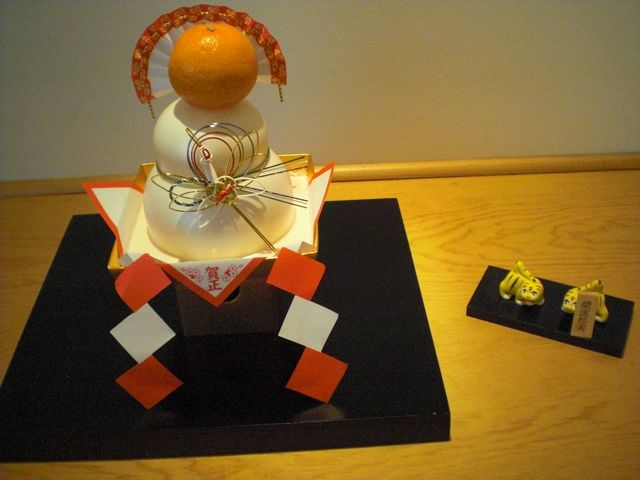
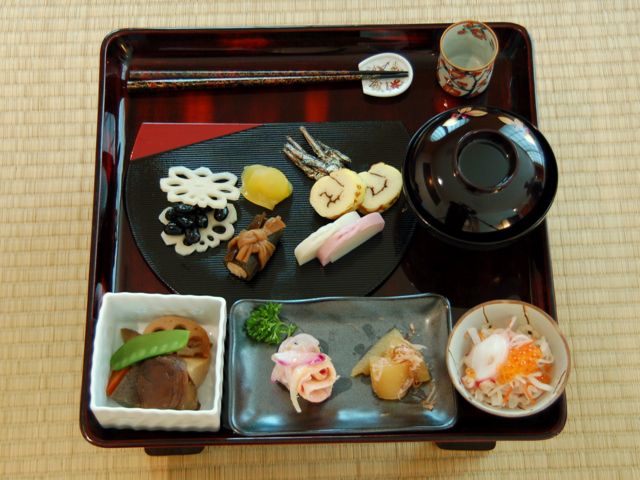
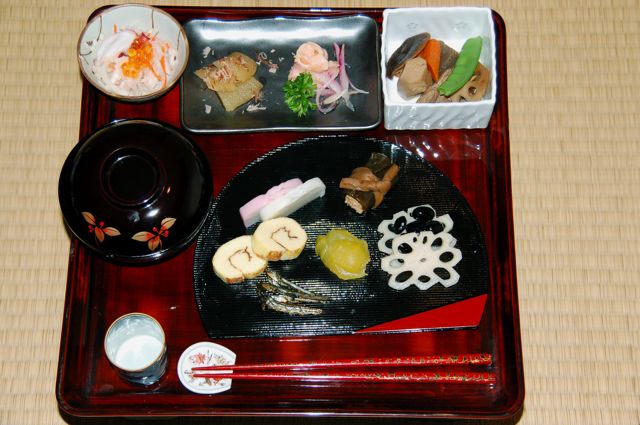
New Year Soup お雑煮
Only unusual thing I do is to put "mochi" 餅 or rice cake in " fried tofu pouch "aburage" 油揚 as per my wife's request. So that the sticky mochi will not dissolve or attached to your teeth and the bowl. In addition to keeping the mochi under control, the combination tastes pretty good.

Assorted appetizers "Kuchitori" お口取り
Small fish ごまめ, red and white fish cakes 紅白かまぼこ, sweet chestnut 栗きんとん and black beans 黒豆 are bought ready made. The rest were home made. Rolled omelet 伊達巻きwas made from eggs and commercial "hanpen" はんぺん a type of white fish cake, lotus root or renkon レンコン was bought already cleaned and boiled but then I made this "flower" cut and vinegared it. For the first time, I also made kelp roll with salmon 鮭の昆布巻き, which, if I say so myself and my wife (who is impartial) also agrees that this was much much better than the commercial product.

Vegetable and chicken stew 筑前煮
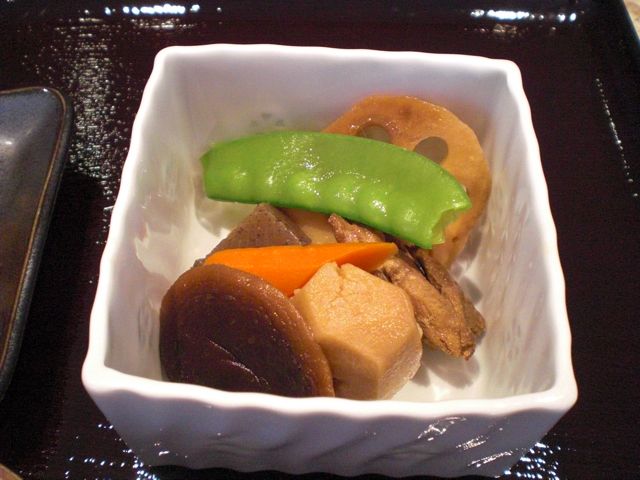
Marinated salmon 鮭のロシア漬け、Herring roe 数の子
This salmon dish is my mother's recipe. She does not remember where she got it. Thinly sliced salmon was layered with onion, lemon slices and marinated in a mixture of sake, rice vinegar and olive oil for at least 3 days. The herring roe was first soaked in weak salt water to remove salt (they are sold preserved by heavily salting) and then marinated in dashi, mirin, and soy sauce mixture for a few days.
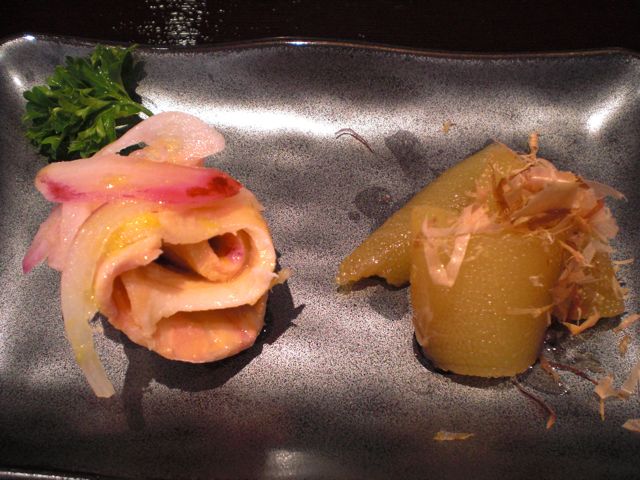
Julienned Daikon "Namasu" in sweet vinegar 大根なます, vinegard octopus 酢蛸,
Salmon roe いくら
For "Namasu", as per my mother's recipe, I do not add water or dashi and we like more assertive vinegar taste. The octopus was bought boiled and frozen and then sliced and vinegared before serving.
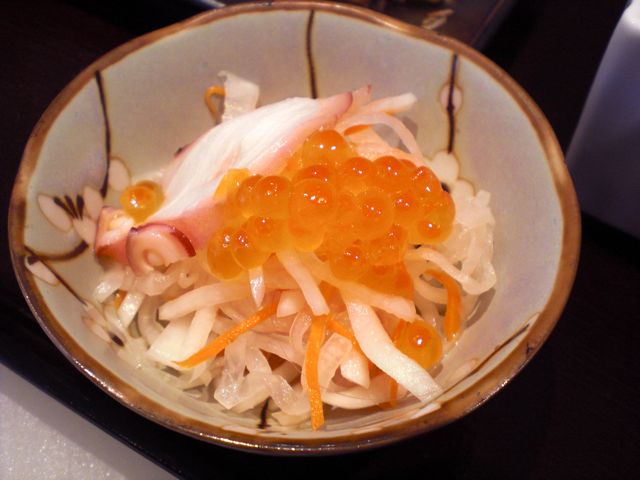
Chicken patty with pine nuts and miso 鶏肉野松風焼き, Scotch egg スコッチエッグ
I used boiled quail eggs rather than hens eggs for my Scotch eggs.
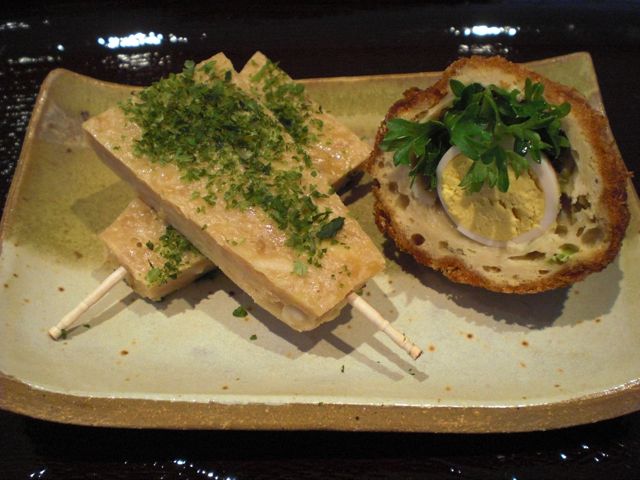
Only unusual thing I do is to put "mochi" 餅 or rice cake in " fried tofu pouch "aburage" 油揚 as per my wife's request. So that the sticky mochi will not dissolve or attached to your teeth and the bowl. In addition to keeping the mochi under control, the combination tastes pretty good.
Assorted appetizers "Kuchitori" お口取り
Small fish ごまめ, red and white fish cakes 紅白かまぼこ, sweet chestnut 栗きんとん and black beans 黒豆 are bought ready made. The rest were home made. Rolled omelet 伊達巻きwas made from eggs and commercial "hanpen" はんぺん a type of white fish cake, lotus root or renkon レンコン was bought already cleaned and boiled but then I made this "flower" cut and vinegared it. For the first time, I also made kelp roll with salmon 鮭の昆布巻き, which, if I say so myself and my wife (who is impartial) also agrees that this was much much better than the commercial product.
Vegetable and chicken stew 筑前煮
Marinated salmon 鮭のロシア漬け、Herring roe 数の子
This salmon dish is my mother's recipe. She does not remember where she got it. Thinly sliced salmon was layered with onion, lemon slices and marinated in a mixture of sake, rice vinegar and olive oil for at least 3 days. The herring roe was first soaked in weak salt water to remove salt (they are sold preserved by heavily salting) and then marinated in dashi, mirin, and soy sauce mixture for a few days.
Julienned Daikon "Namasu" in sweet vinegar 大根なます, vinegard octopus 酢蛸,
Salmon roe いくら
For "Namasu", as per my mother's recipe, I do not add water or dashi and we like more assertive vinegar taste. The octopus was bought boiled and frozen and then sliced and vinegared before serving.
Chicken patty with pine nuts and miso 鶏肉野松風焼き, Scotch egg スコッチエッグ
I used boiled quail eggs rather than hens eggs for my Scotch eggs.
Wednesday, December 30, 2009
Seared Tuna salad 炙り鮪のぬたサラダ
Again, this is a continuation of how to enjoy tuna sashimi in different ways. Mark's book (p80) has a similar more traditional recipe, "Tuna 'Nuta' with Miso Mustard dressing". I make this dish slightly differently. "Nuta" ぬた is a traditional Japanese dish in which raw fish, sea weed, and "wakegi" わけぎ (which is very similar or identical to scallions -green or spring onions- we get in the U.S.) are dressed in sweet miso mustard sauce "karashi sumiso" からし酢みそ. I made some modifications to this traditional recipe and made it into a salad. I used the "tataki" technique for tuna and cooked the scallions over direct gas flame. This way, the tuna attains a nice firm texture and the scallions become very sweet. You could just boil the scallions as suggested in Mark's book. For added texture, I used grilled "abura-age" 油揚げ or deep fried tofu pouch and everything was set on the top of dressed greens (I used baby arugula here but any leafy greens will do). Of course, if you omit the greens, that will also be just fine with sake.

I used 1/3 "saku" 冊 or block of tuna sashimi (previously frozen) for two servings. After thawing, remove any moisture from the surface and salt both sides. To sear the surface, you could use a frying pan with a bit of oil but I used the traditional Japanese method of a direct gas fire (or charcoal fire). I put two metal skewer, fanned out, through the tuna and held it over the flames until all surfaces were white with small light brown patches but the center was still raw. I plunged the tuna into ice water to cool. I then dried with paper towels and cut into bite size pieces.
I selected thick scallions (3-4) rather than thin ones. Holding the green part, I charred the white part of the scallion over the direct flame until the outer skin blackened. I set them aside until they were cool enough to handle (1-2 minutes). I then removed the root end and outer most blackened layer and cut the white and contiguous green parts into 1/2 inch long segments.
I put one abura-age in a toaster oven and toasted it like I would a slice of bread until surface was brown and crispy (I could have used direct flames as well). I cut it into 1/3 inch strips.
To make "nuta" or "sumiso" sauce (I posted this before); this time I used regular white miso (2 tbs), sugar (2 tbs) and mixed in enough rice vinegar to make a saucy consistency. If the sauce is vinegary enough but still too thick, you could add a bit of 'dashi" or sake. I also added 1/3 tsp of prepared hot Japanese mustard. In Mark's book, this sauce was made with the addition of mirin without sugar (mirin is sweet) and less vinegar which makes the sauce less vinegary but I like a more assertive vinegary taste. Dress all the above ingredients except for the greens with this sauce.
For the baby arugula, I simply dressed with a splash of rice vinegar and good quality olive oil, salt and black pepper.
Just place the greens on the bottom of the plate and make a mound of "nuta" on the top. My wife usually does not like scallions in big pieces but this time because of the method of cooking them they were very soft and sweet and she liked it. Abura-age added a nice crunch and everything came together with the smooth miso sauce. Arugula has nice peppery taste which also added to the overall flavor.
To make "nuta" or "sumiso" sauce (I posted this before); this time I used regular white miso (2 tbs), sugar (2 tbs) and mixed in enough rice vinegar to make a saucy consistency. If the sauce is vinegary enough but still too thick, you could add a bit of 'dashi" or sake. I also added 1/3 tsp of prepared hot Japanese mustard. In Mark's book, this sauce was made with the addition of mirin without sugar (mirin is sweet) and less vinegar which makes the sauce less vinegary but I like a more assertive vinegary taste. Dress all the above ingredients except for the greens with this sauce.
For the baby arugula, I simply dressed with a splash of rice vinegar and good quality olive oil, salt and black pepper.
Just place the greens on the bottom of the plate and make a mound of "nuta" on the top. My wife usually does not like scallions in big pieces but this time because of the method of cooking them they were very soft and sweet and she liked it. Abura-age added a nice crunch and everything came together with the smooth miso sauce. Arugula has nice peppery taste which also added to the overall flavor.
Subscribe to:
Comments (Atom)

